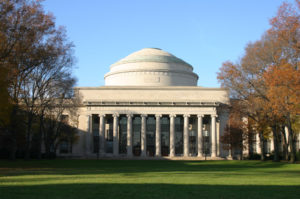
An advanced ventilation system that adjusts airflow according to outdoor temperatures and how many people are in a room could help the Massachusetts Institute of Technology save $100,000 annually as the university continues to trim its energy use.
MIT teamed up with air quality company Aircuity on Aug. 16 to equip the university’s Hayden Library and the Sloan School of Management with a ventilation infrastructure that will help reduce electricity use by 15 percent in the next three years, according to Aircuity’s web site.
The new system, called OptiNet, includes an HVAC optimizer mode and sensors that constantly measure air quality–critical elements for schools and businesses looking to bring down energy costs.
The partnership with Aircuity, a Massachusetts-based company, is the latest in a series of new green policies first announced by MIT in May, when MIT committed to a three-year energy savings of $34 million kilowatt hours, or the electricity used by about 4,500 homes annually.
The energy-savings plan, dubbed “MIT Efficiency Forward,” was recognized in May as “the single most aggressive efficiency project” in the history of NSTAR, an electric and gas utility working with MIT officials to reach the school’s goal of reducing electricity use by 15 percent by 2013.
MIT could save up to $50 million through campus renovations, electric and gas incentive programs to promote efficient energy use, and construction centered around sustainability, according to projections published by NSTAR.
“Aggressive goals require aggressive action, and MIT is demonstrating its leadership in campus sustainability once again,” said Tom May, chairman and president of NSTAR. “They are taking advantage of every energy-saving tool NSTAR has available and I’m confident the results will be a model–and an inspiration–for all other customers to follow.”
MIT, despite its ambitious three-year environmental plan, did not make a list of the top 100 “coolest schools” published this month by Sierra magazine, the publication for the Sierra Club that ranks the most environmentally-friendly colleges and universities every year.
Green Mountain College in Poultney, Vt., was ranked No. 1 by the Sierra Club thanks to its use of biogas from cows and plans to be carbon-neutral by 2011. Green Mountain finished 35th on Sierra’s 2009 list of green schools.
Dickinson College in Carlisle, Pa., which runs a high-efficiency power plant, was ranked second. And Evergreen State College in Olympia, Wash., was ranked third after campus officials’ pledge to purchase renewable energy credits for all electricity used during the school year.
Notable colleges and universities included in the top 100 greenest campuses as ranked by the Sierra Club were Stanford University at No. 5, eighth-ranked Harvard University, No. 20-ranked New York University, and No. 46-ranked University of Michigan.
Sierra’s results were based on an 11-page questionnaire sent to 900 campuses nationwide. The magazine received 162 responses, “nearly all of them painstakingly thorough,” according to Sierra’s web site.
The 2010 rankings had nine schools in the top 20 that had never made the list before.
- Research: Social media has negative impact on academic performance - April 2, 2020
- Number 1: Social media has negative impact on academic performance - December 31, 2014
- 6 reasons campus networks must change - September 30, 2014

